What to Expect When You Stay With Mongolian Nomads
One of my favourite ever travel experiences was staying with a Mongolian nomadic family in the remote countryside. Experiences included eating with the family, shearing their sheep, horse riding and some, err…. less pleasant stuff which we’ll get into later on.
The entire experience cost me £45.99, which was US$58.82 or ₮195,702 (Mongolian tugrik) at the time. I will break down costs in full later on, so you have a good idea of how much it will cost you to do a similiar experience.
I will talk in detail not just about what the experience involved, but also how you can do it too, whilst also touching on safety.
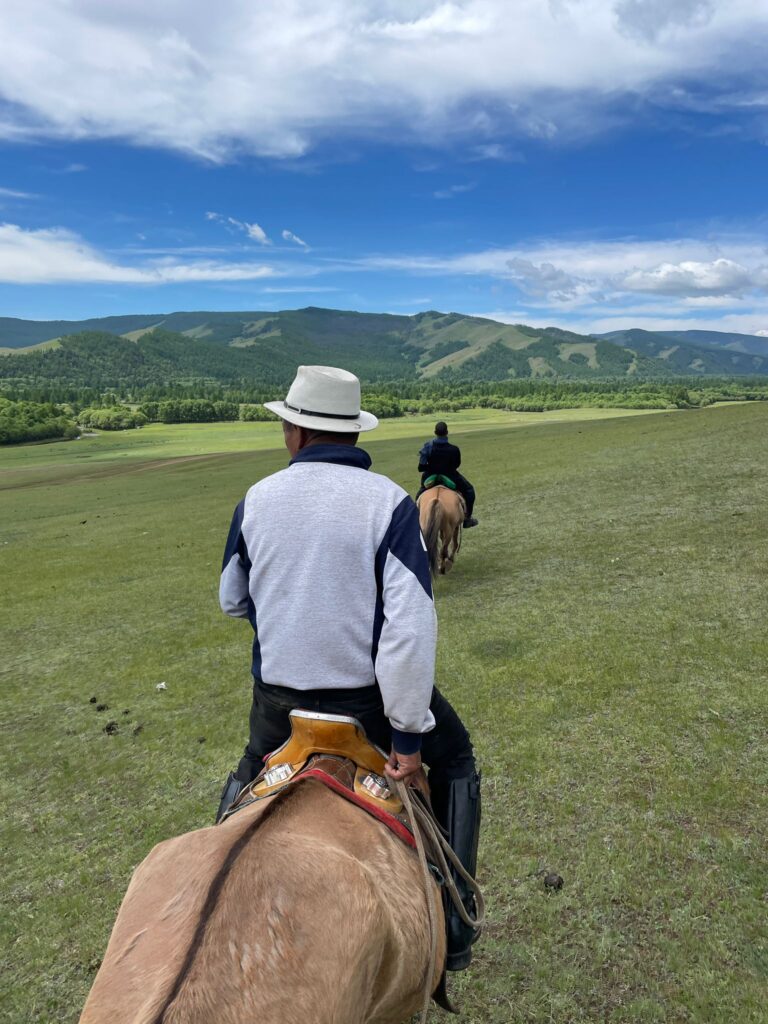
How to Stay With Nomads in Mongolia
Booking Tours
The easiest way to arrange a nomad homestay experience is to book a tour. The cheapest way to do this is by turning up to hotels, hostels and guesthouses, where you can arrange a trip in person.
Booking online is more expensive.
Another benefit of talking to staff in person, is being able to customise your excursion, and enable the tour provider to offer something most closely suited to what you’re looking for.
I booked through my accommodation in Ulaanbaatar, the excellent Danista Nomads Hostel. They have both shared and individual rooms, and I highly recommend staying there by the way.
I booked their most popular day tour trip, to nearby Terelj National Park and the Chinggis Khaan Statue Complex. But instead of coming back after seeing these places, I met up with a local nomad who took me deep into the countryside, where I was able to live, eat, work and play with his family.
Make sure you negotiate this part with your accommodation. Whilst there are several cool things to do in Ulaanbaatar, and both the statue complex and Terelj are cool things for a day, it is the nomad experience which really makes visiting Mongolia worthwhile.
Volunteering With Local Families
Another method you can use to stay with nomadic families, is to use websites such as Workaway which offer volunteering opportunities abroad.
With Workaway, some opportunities are free and others can cost money. There are even some that will pay you a small wage. Each opportunity is different. Generally your host will provide you with accommodation and food in exchange for you helping them with some form of labour.
I met a Workaway volunteer who was also staying with my host family. He had arranged this opportunity online several months in advance. It cost him around £100 (US$128) to stay and work with them for 4 days. This is a third of the original price he was quoted.
Please note that it does cost €49 (£42/US$53) to sign up to Workaway in the first place for a 1-year membership. Although it is only €10 more (€59/£50/US$64) for a pair or couple to join, making this a far more cost-effective option.
Not all Workaway opportunities cost money, although the free ones will be harder to find.
How Much Does it Cost to Stay With a Mongolian Nomadic Family?
Breakdown of my Costs for a Mongolian Nomadic Experience
The costs will vary depending on who you go with, how many of you there are, what specifically you do, and just typical Mongolian “make it up on the spot” culture.
Whilst the latter may sound like a typical travel scam, that’s not the case, and my host family charged a lot less than the staff at my hostel had said it would cost. However Mongolians do have a habit of “winging it” and making up prices without putting too much thought into them, so it can be luck of the draw really.
Let’s have a look at everything I paid for this experience and everything linked to it, with prices in Mongolian tugrik (₮), British pounds and US dollars.
- 1 night’s accommodation in a typical Mongolian ger: ₮20,000 (£4.70/US$6.01)
- A day tour to Terelj National Park and Chinggis Khaan Statue Complex (half price as divided between two people): ₮102,128 (£24/US$30.69)
- Meals (dinner, breakfast and lunch): ₮30,000 (£7.05/US$9.02)
- Entry to Aryabal Meditation Monastery at Terelj National Park: ₮2,000 (£0.48/US$0.61)
- 1 hour of horseriding with the nomads: ₮20,000 (£4.70/US$6.01)
- Taxi back to Nalaikh: ₮20,000 (£4.70/US$6.01)
- Bus from Nalaikh back to Ulaanbaatar: ₮1,000 (£0.24/US$0.31)
- Bus back to hostel on the other side of Ulaanbaatar: ₮500 (£0.12/US$0.15)
- Total: ₮195,702 (£45.99/US$58.82)
Now this is simply what I paid. And there will be variations to your own costs, but they shouldn’t differ by much.
Also remember that exchange rates constantly fluctuate.
There are two things I didn’t pay for, which you may end up spending money on.
Firstly, the Chinggis Khaan Statue Complex is free to visit from the outside, but costs ₮20,000 (£4.70/US$6.01) if you wish to go inside and see the small museum and viewpoint from on top of the record-breaking statue.
Secondly, there is a ₮3,000 (£0.72/US$0.92) entry fee to Terelj National Park. However, in typical Mongolian fashion, they stopped some cars to charge the entrance fee, and waved others (including ours) straight through without charging the fee.
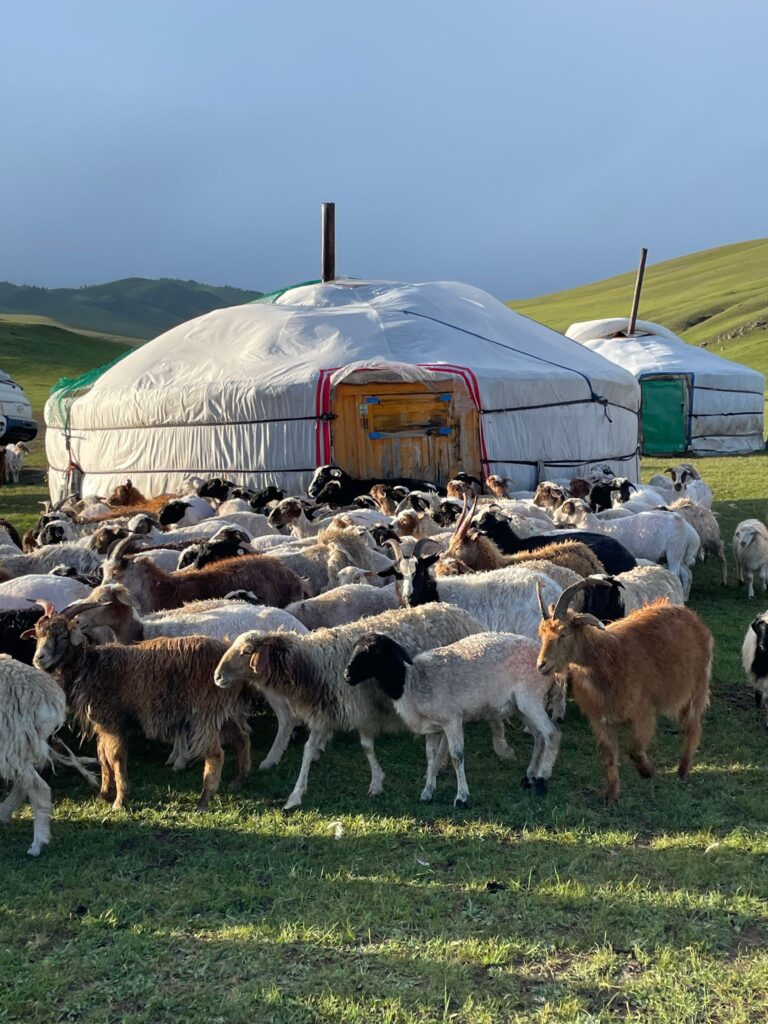
Do you Need to Take a Tour of Terelj and Chinggis Khaan Statue Complex to Stay With Nomads?
Now let’s talk about the tour cost here.
Technically, you don’t need to take the tour of the statue complex and national park (including the monastery) to stay with nomads. However, the logistics can be challenging without it. You would otherwise have to take a bus out of Ulaanbaatar and meet with a nomad family in a pre-arranged location.
This can be tricky due to Mongolia’s lack of reliable internet outside of Ulaanbaatar, as well as erratic bus routes and timings.
It may also end up costing you more money to go independently.
My Recommendation for a Smooth Issue-Free Experience
If you want to guarantee meeting nomads without issues, make sure you either combine it with a Terelj/statue complex tour, or take a taxi directly from Ulaanbaatar with a reliable driver who can connect you with your host family.
And to be honest, a taxi won’t really save you any money compared to doing the tour. In some ways, the tour is pretty much free as the money you spend is primarily for the driver. The distance is the same if you meet nomads in the same way I did. As the meeting point was in Terelj.
Tours are often expensive in Mongolia, and the Terelj/statue complex tour, offered by pretty much every hotel, hostel and guesthouse, is the cheapest outside the capital.
The full price of the tour is around the US$60 (£47/₮200,000) mark, but this cost is divided by the number of people who go. Therefore it’s half price for two of you, a third for three, a quarter for four and so on.
What is the Cheapest Way to Stay With Mongolian Nomads
The cheapest way to do this experience is to take buses to and from Ulaanbaatar (not recommended due to the logistical difficulties and high chance you may have problems meeting up) without the tour. Then you will only be paying for the accommodation, meals and bus tickets as guaranteed expenses.
These cost ₮53,000 (£12.47/US$15.95) based on my own expenses. However, you will also need to factor in getting from the bus stop to the nomadic ger camp. On the way to the camp, this was included in the price of the tour. On the way back, we paid ₮40,000 (£9.40/US$12.02) for a taxi from the camp to Nalaikh (where we got the bus back from).
Please note that the taxi cost was split between two people. Therefore you will need to double this cost for a single taxi, then double again for a two-way journey. Which gives you taxi costs of ₮160,000 (£37.60/US$48.08) in total.
Therefore for one person, you can stay with nomads for around ₮213,000 (£50.07/US$64.03) for an individual, with the taxi cost divided by the number of people in your group.
You may have noticed, this is actually more expensive than what I paid, which included the tour and horse riding.
Therefore, you are relying on meeting nomads who will give you a free lift to and from their camp. This will save the taxi expenses for you and slash the cost back down to a much cheaper ₮53,000 (£12.47/US$15.95) once again.
Of course, sharing with others slashes the taxi costs down, but this is also the case for taking a tour.
Of course, there are no guarantees that your host family will offer free rides, and other expenses are likely to have slight variations compared to mine.
This is the cheapest way to stay with Mongolian nomads, but NOT the best way. And it may not work at all if the logistics fall through.
Once again, my recommendation would be: take a tour. Some of you, like me, may prefer to travel independently. However, here it is not worth it and your experience will be far more enriching by going with professionals who are used to arranging these experiences.
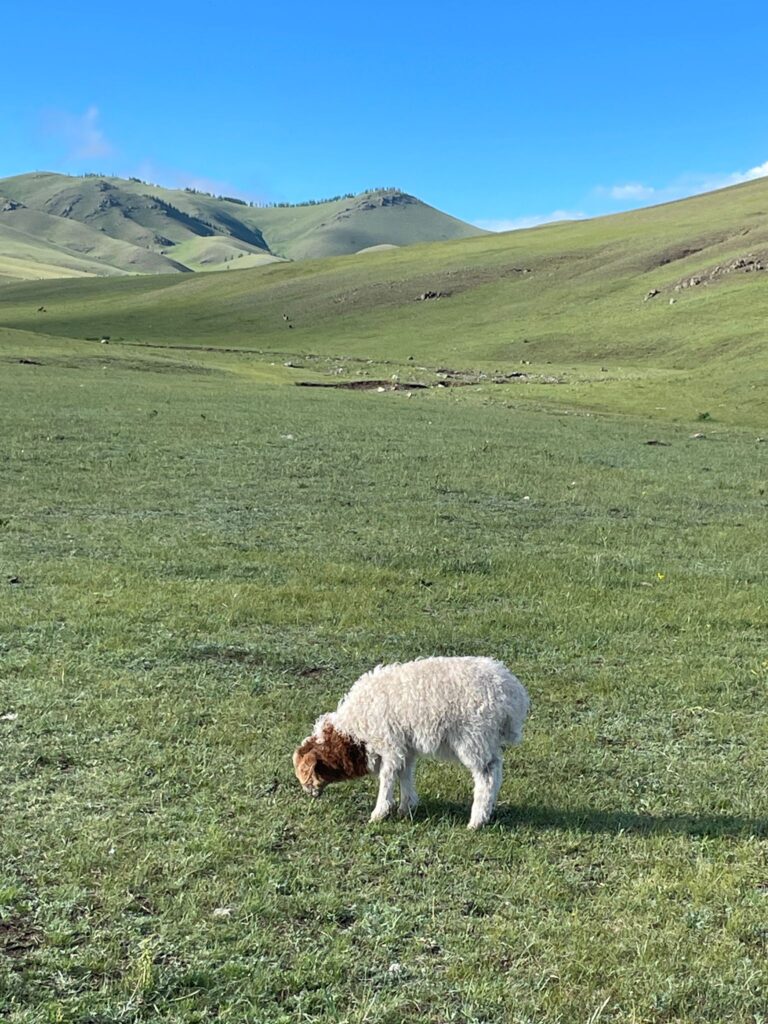
What to Expect When You Stay With Mongolian Nomads
Now this is my personal experience, and yours will differ slightly, but read on if you want a good idea of what to expect if you do what I would call the most magical activity in Mongolia.
I’ll explain exactly what I experienced during just over a day in the wilderness with a Mongolian family.
Hopefully you will enjoy this raw and authentic experience just as much as I did!
Meeting the Nomads
It started with a day tour from my hostel. It was a typical tour to Chinggis Khaan Statue Complex followed by Terelj, the most popular of Mongolia’s national parks. Albeit the most popular due to its close proximity to the capital city, Ulaanbaatar.
I was joined by one other person from my hostel, which instantly slashed the tour costs in half.
After a few hours which involved seeing the Zaisan Hill Memorial, heading to the statue complex, and viewing a couple of sites at Terelj, we were dropped off on the outskirts of the national park.
Our English-speaking driver introduced us to a local nomad wearing well-worn sports clothing including a zip-up Adidas jacket.
He later introduced himself as Khatan. Although this seems an oddity as that is generally a girl’s name in Mongolia.
He spoke no English, and we spoke no Mongolian, which made communication a little tricky.
It seems “Khatan” is most likely just a small part of his name. It means “queen” in Mongolian, although can become a more masculine name when combined with another word on the end.
For example, “Khatanbaatar” means “queen saver”, and is a name that some males have, most notably former general Khatanbaatar Magsarjav.
Anyway, he told us he was “Khatan”, so let’s call him that.
I doubt you came here for a lesson on Mongolian naming conventions. So, let’s carry on with the story.
Khatan led us down a narrow alleyway, taking us away from the touristy parts of Terelj, down a series of paths over rivers, slowly edging away from civilisation.
After around 15-20 minutes of walking, his friend picked us up in a car, which was designed for offroad travel, essential in rural Mongolia.
Slowly we drove through the stunning green hills, eventually distancing ourselves from Terelj and arriving in a clearing with three typical Mongolian gers, set up in the middle of nowhere.
Only the hills, a dried up river-turned-rubbish dump and a livestock pen surrounded the gers (sometimes known as yurts).
We were finally away from the city life and fully immersed in nature.
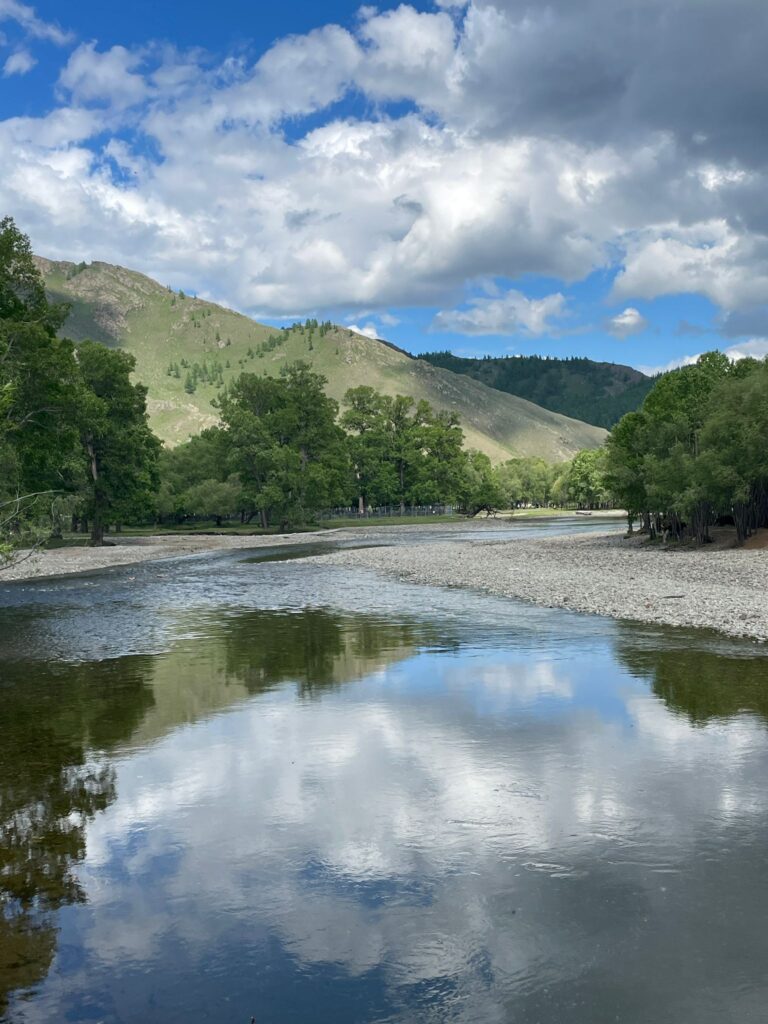
Dinner in a Mongolian Ger
Of the three gers, one was purely for the family, one was full of beds for guests, and the other had Khatan’s bed, alongside a dining area and a kitchen space.
There were several rustic cooking appliances, most notably a metal stove which, like the rest of the kitchen space, looked like it could easily have been over 100 years old.
In some ways, the kitchen space looked like a throwback to Victorian Britain.
We met a Workaway volunteer who had been helping Khatan’s family with their livestock. He explained to us that he had seen the nomads kill a sheep the previous night, which had since been hacked to pieces.
He explained that it would feed everyone for 1-2 weeks.
Given the fact the family had around 100 sheep and goats, this was enough meat to keep them fed for 2-4 years. Although they do often lose animals to wolves in the countryside.
Khatan cooked lamb, pasta, rice and vegetables for us. Mongolian food often gets a lot of criticism, but this basic meal was pretty good.
Not so good however were the accompanying stale biscuits, and bread which Khatan used as a resting place for his phone.
Now if you’re looking for western hygiene standards, you won’t find them out here. A dead cockroach was lying in a filthy ashtray during my entire stay, whilst the same knife was used for everything from cutting vegetables to outdoor use.
Water is very limited out here. Therefore the knife barely gets washed. Rainfall can be scarce in the Mongolian countryside, and what little water is collected, has to be carefully rationed.
You may be wondering what the nomads drink, if water is so hard to come by.
The answer is milk tea. Suutei tsai is the official name for this salty tea, which comes from the family’s livestock.
It’s certainly an acquired taste. Quite bitter and certainly not the best drink of my life. But you have to get used to roughing it for a bit if you want an authentic rural Mongolian experience.
Dairy products are common in the Mongolian countryside, as they have to make use of the limited resources they have.
I must admit that this experience was a gamble with food poisoning risks. If you have to be careful with food preparation and hygiene, I must admit that you will most likely struggle out here.
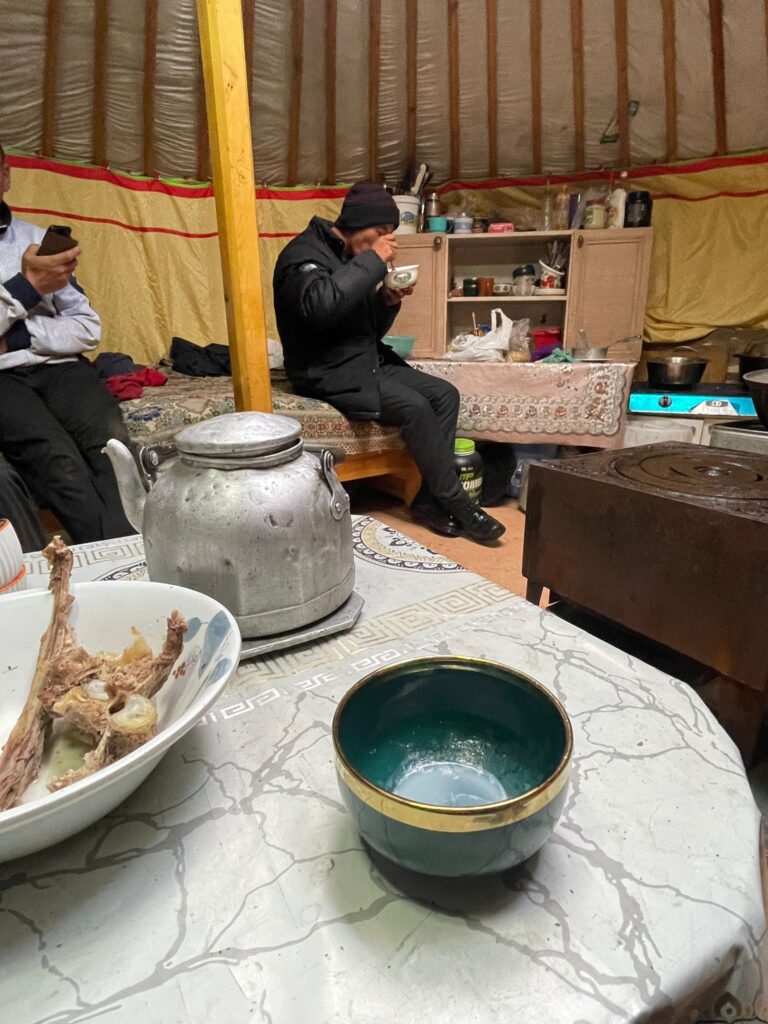
Sleeping in a Ger
Regardless of whether you’re in Eastern Mongolia, Western Mongolia, the Gobi Desert or elsewhere, Mongolians stay in gers outside the city.
If you’re familiar with the term “yurt”, this is the same thing, just in a different language (ger is the correct Mongolian term).
The kitchen ger surprisingly had some electricity, powered by solar panels. It had a TV that wouldn’t look out of place in the early 1990s, and the nomads even had smartphones.
These were small glimpses of modern life, in an environment that otherwise seemed like a throwback to many centuries ago, when concepts like the internet and TV would have seemed as farfetched as flying houses may be today.
The accommodation ger had no such luxuries. This just had a few beds lined around the edges, a sink with barely a trickle of water coming through, and an iron stove in the centre with a large pipe coming out the top for heating.
We settled down to play cards as the sun began to set. But with temperatures dropping sharply, Khatan turned on the stove using a lighter, and a gas canister which was placed dangerously close to the fire…
Within minutes, the stove was so effective, we had the opposite effect. Instead of shivering in coats, suddenly it was far too hot even in t-shirts.
We opened the ger’s door, using some stools to prop it open. Only to find that the sheep wanted to come and join us.
Every few minutes, one of the small lambs would successfully clamber over the stools, and make it inside the ger. We would then have to pick them up and take them outside again!
Eventually, it was time to sleep. The embers of the stove began to fizzle out, and once again the chill was upon us.
The gers are insulated with felt, but still get pretty chilly without heating.
Being in the Mongolian wilderness is an adventure, not a luxury comfort holiday. So it was time to sleep in a jacket under the thin duvet Khatan’s family had provided.
The bed wasn’t comfortable, but we made it through the night. The experience was worthwhile. But sleeping here wasn’t the highlight. The best was yet to come…
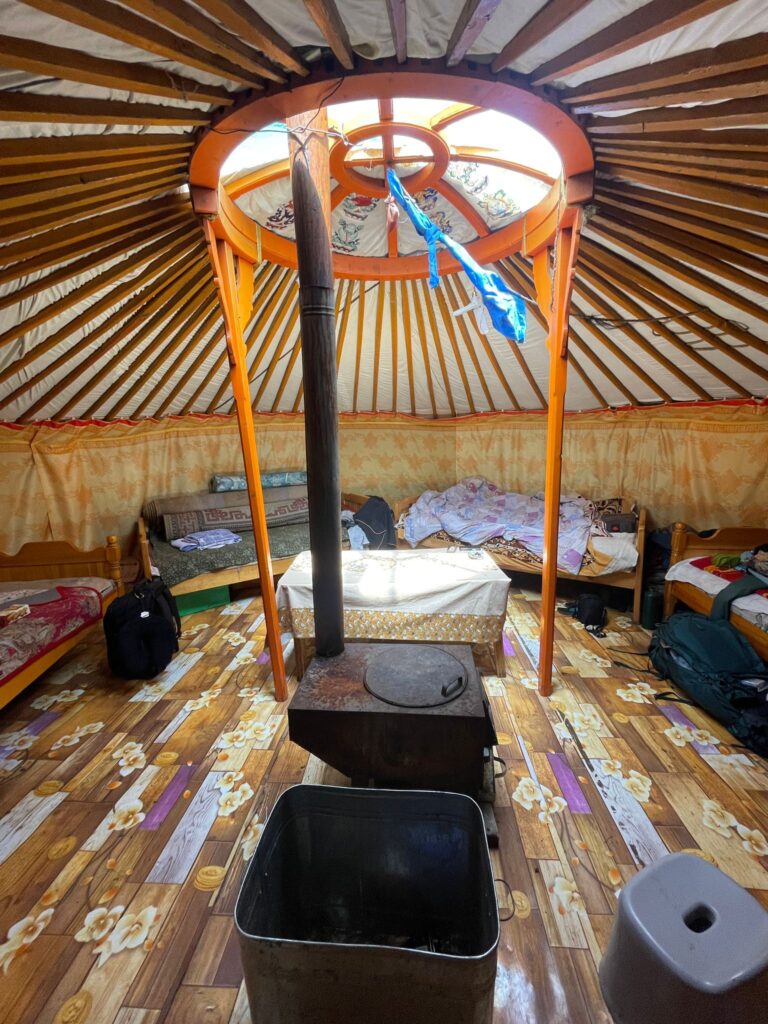
Helping out With the Family’s Animals
Breakfast
The next day started with breakfast. It was mostly the leftovers from the previous night. There was the remaining lamb, now looking a lot less delicious than it had 12 hours previously.
The biscuits were even more stale, likewise the bread, and of course we washed it all down with some suutei tsai.
Then it was work time.
The volunteer would be helping the nomads manage their livestock, and we went to join him.
Rounding up the Herd
The first job was to round them all up into the pen. Around 100 sheep and goats. I’m not a countryside person, therefore it was a surprise to see how easy it was to control such a big flock.
I now know why the term “sheep” applies to anyone who blindly follows the crowd.
We simply walked behind the animals, gave the odd clap or shout of “oi”, and followed them round the pen before they went inside.
After locking the animals inside, it was time to get mucky. We climbed over the fence and Khatan, with the help of his cousin, would catch sheep for us to shear.
Shearing the Sheep
But there are no fancy tools in rural Mongolia. There was only one pair of scissors, which Khatan kept to himself.
We were ripping the wool off the sheep with our bare hands. We were a little apprehensive to begin with, but soon found that it doesn’t hurt the sheep and began to get into it.
This is hard work though.
The nomads tied the sheep’s legs together so they couldn’t escape during this process. But the wool is tough to pull and doesn’t easily come off, certainly not without breaking into messy clumps.
It took a while to get even a small amount of wool off the sheep. Needless to say, Khatan made it look effortless as he showed us how to do it.
The lady on the tour with me picked up one of the lambs and it decided to poop on her jacket.
Lovely stuff.
I hesitated over whether to include that small detail here, but that is the reality of working with livestock in rural Mongolia. This isn’t a luxurious Maldivian resort break, so don’t come out here expecting everything to be all clean and polished.
The opposite is true.
Eventually we had enough wool, and moved onto the next activity.
Shovelling the…
As Khatan and his cousin started milking the goats, the three of us visitors had something a little more mucky to do.
When the animals are outside the pen, they generally gather in a large mud patch just outside. And they poop absolutely everywhere. Multiple times per square metre…
So what was our job? To clean it all up!
We were given shovels which we used to scoop it into small piles. We would then collect the piles in a wheelbarrow, before dumping them onto a giant manure pile in the dried-up former river.
The Mongolian nomad family then use this to heat the gers when it gets cold.
We did this for a couple of hours in the blazing Mongolian sun, which can give you some pretty nasty sunburn if you aren’t careful, as the strong winds tend to hide just how hot it really is in the summer here.
So How Was Life Working With the Nomads?
The strangest part of this experience?
It was actually really good fun! I genuinely enjoyed this much more than a standard day walking around any generic European city seeing cathedrals and eating in restaurants.
This is real travel. Trying something different, getting stuck into a lifestyle completely different to your own, and getting your hands a bit dirty.
I would highly recommend this to anyone.
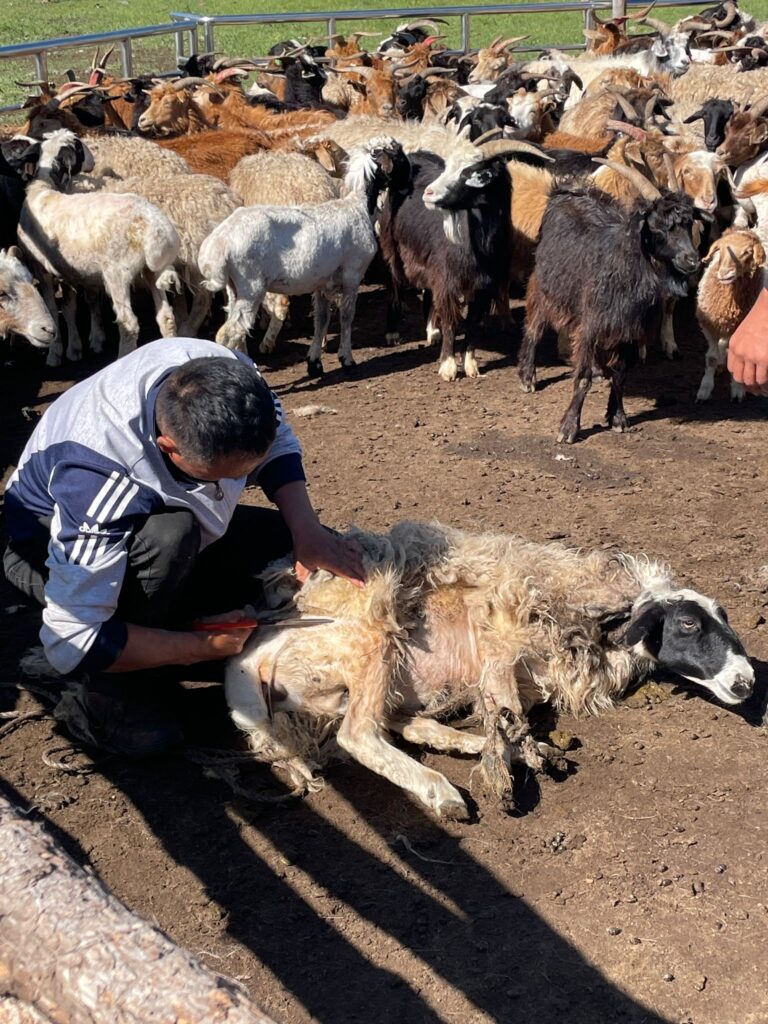
Horse Riding Through Rural Mongolia
In Mongolia, horseback riding is a deep tradition, a primary method of transport for many nomads, and one of the country’s biggest sports.
You haven’t had a complete Mongolian life experience, until you’ve joined the locals for a trot around the countryside.
And sure enough, after finishing our work, that’s exactly what we did!
Khatan and his cousin prepared the horses, put the saddles on and got them ready. Then finally, it was time to go.
I had never been horseback riding before, with the exception of 5 minutes in Paraguay which was more of a touristy “get on the horse and a guide will walk you round a short circuit” kind of thing.
Paraguay by the way, is one of Latin America’s safest countries, and one which like Mongolia, is very much off the beaten tourist trail. Worth checking out if you love a more rugged and authentic travel experience like I do.
Fortunately, I seemed to get the calmest horse. The volunteer was unfortunate, with his horse desperate to be anywhere but there. Thankfully, he had some experience and was just about able to handle it.
And off we went, cantering through the green hills surrounded by nothing else but blue skies and white clouds.
The vastness of the wilderness makes it unsurprising, when you realise that Mongolia is the world’s most sparsely-populated country with just over 2 people per km² (the global average is 62 people per km²).
Rural Mongolia is an introvert’s dream.
After an hour, we headed back to the gers.
You can negotiate if you want to ride for longer. I went with the shorter option for my first proper horse riding experience. After all, you wouldn’t run a marathon on the day you learn to walk… right?
And that was the final activity before Khatan gave us one final lunch, once again consisting of whatever was left over from the previous night and from breakfast. Then he took us back to Terelj, before we headed to Nalaikh, and eventually Ulaanbaatar.
After several frustrating days in the capital struggling to find local experiences, my persistence had paid off and Mongolia skyrocked into my list of top countries.
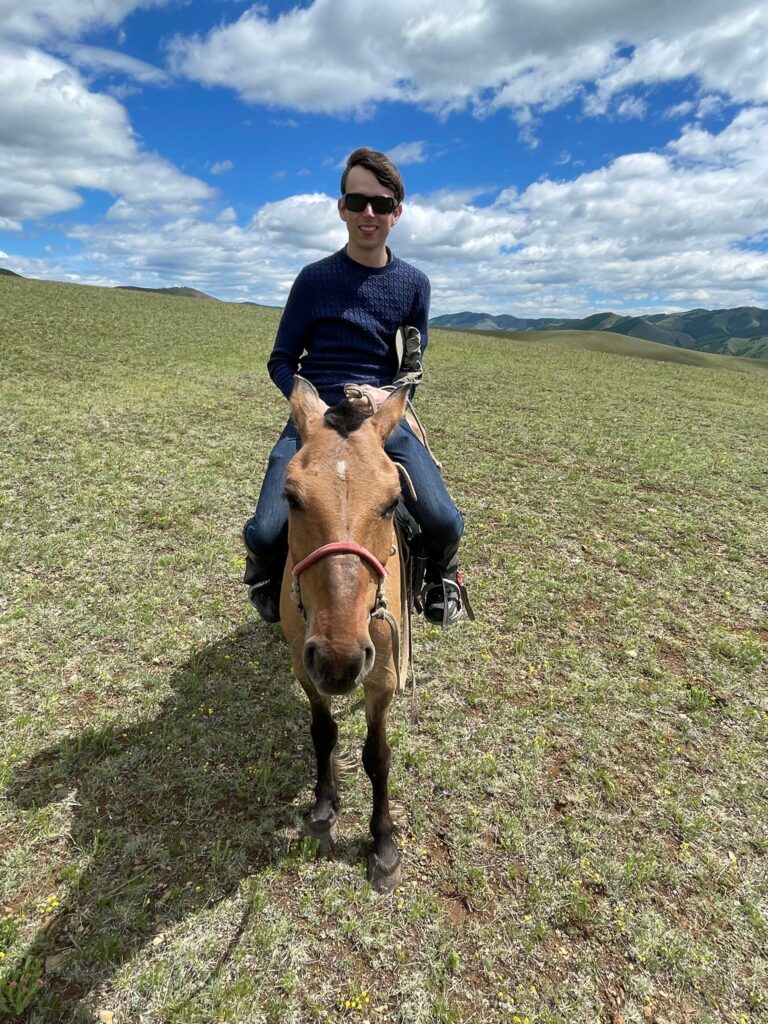
Is it Safe Staying With Mongolian Nomads?
When debating whether or not a country is safe, people generally focus on crime.
In many cases, crime is not the issue to worry about. And that’s certainly the case here.
Mongolian nomad families are very humble people whose lives revolve around family and nature. They are not materialistic at all and your chances of being robbed are miniscule.
Likewise, you don’t have to fear violence. These are calm people who will happily look after you and treat you with respect and a level of hospitality which may come as a culture shock for fellow westerners, not so used to having the red carpet rolled out by strangers.
There are two dangers in rural Mongolia however, which you should be aware of.
Lack of Access to Healthcare
If you fall ill or have an accident, whilst horseriding for example, then you won’t have access to healthcare at all.
Mongolia is a massive country, the 18th-biggest in the world in fact. And the transport systems are pretty poor in all honesty. Likewise internet and phone connectivity outside of the cities.
In other words, you most likely won’t be able to contact anyone for help. And even if you can, it will take (at best), several hours to get back to civilisation.
Don’t expect a helicopter to winch you to safety, or an ambulance to come and pick you up out here.
If something happens, I’d advise having a first aid kit with you, and preferably some first aid training. Better still if you’re travelling with others who can help you.
Mongolia is an adventure destination, not one with western-standard facilities. So don’t expect a lot of help if something goes wrong in the wilderness.
The Extreme Cold
Mongolia is one of the world’s coldest countries (behind only Canada and Russia on average), with temperatures often dropping below -30°C/-22°F in the winter, sometimes even hitting -40°C/-40°F.
Visiting during the coldest months (November-March) should be avoided as the risk of frostbite is very high.
Even when I went during the summer, it was jacket weather for the majority of my time in the countryside. The sun was out but strong winds sent the temperatures tumbling.
The heating within the gers will fizzle out within a few hours, leaving you open to the extreme chill when you sleep.
Yes, the nomads survive in this weather, but if you aren’t used to it then it can pose serious dangers.
Avoiding this issue is simple. Arrange your Mongolia nomad experience during the summer.
Is it Worth Staying With a Nomadic Family in Mongolia?
For me, this was one of those “this is why I travel” experiences, up there with watching a volcano erupt in Guatemala and seeing the mysterious Moai statues of Easter Island.
Living with Mongolian nomads for a day was a magical experience I’ll never forget, and if you like a bit of adventure in your life, then I absolutely recommend it. A true 10/10 experience.
It’s not for everyone however. If you love your creature comforts and you aren’t keen on getting mucky, then you’re probably reading the wrong blog post anyway, but this isn’t for you.
Understand that hygiene standards will be well below what you’re used to, you won’t have much choice when it comes to food and drink, the weather can be bitter and you will face discomfort at times.
But if you can overlook that, then you may just be set for one of the best experiences of your life.
